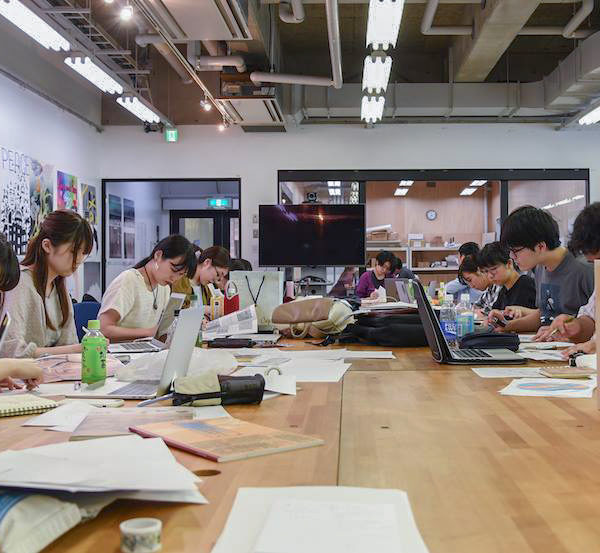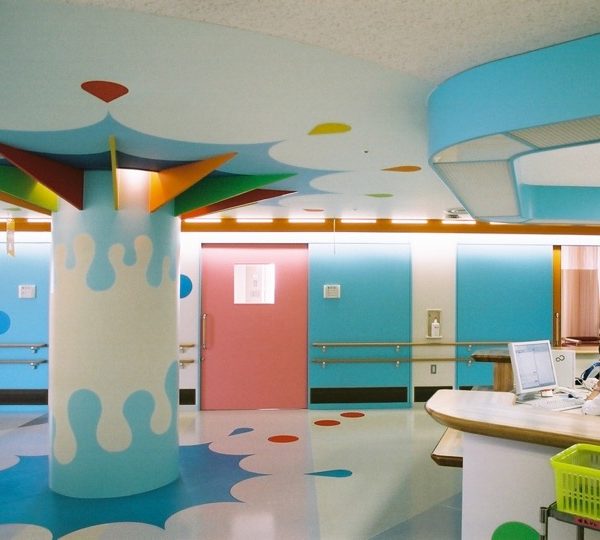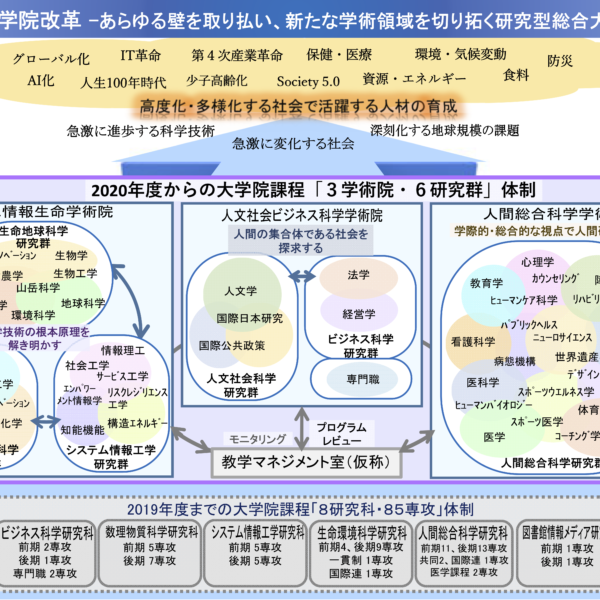CategoryDesign Education

WHEE Project: A Fun Future Created With 5G, AR and Wheelchairs
Under the initiative of the Tokyo Metropolitan Government, the Tokyo Metropolitan University is focusing on research and development related to the local 5G environment from 2020. Our department is leading the “WHEE Project”, a project to develop and provide an outdoor activity support system for wheelchair users, which aims to support independent activities in a fun way with a wheelchair device that has a built-in camera and sensor and AR contents. Professor Kumiko Kushiyama is actively promoting this project. Under the title of “Social Implementation of AI Wheelchair System to Support Fun Independent Movement with AR Games”, we develop assistive technologies and content to help the elderly and people with […]
Read More2022.1.19

Internationalization of the Faculty of Design and the International Office
Establishment of International Office, Faculty of Design In April 2020, the Faculty of Design established the “International Office” to strategically promote internationalization (Fig. 1, Fig. 2). Previously, internationalization was done through individual faculty members, organically linking internationalization operations that were scattered among various departments. The purpose of establishing this office is to systematically promote internationalization and provide a single point of contact (one-stop) for internationalization. The logo of the International Office (IO), Faculty of Design. It is designed to represent the many students and faculty members who will spread their wings to the world through the IO and gather at the Faculty of Design. The Coronavirus Pandemic Right after we […]
Read More2021.12.3

Fundamentals of Modeling and Creative Activities and Expressions
The Department of Design and Applied Arts of Faculty of Arts in Hiroshima City University aims to conduct comprehensive education and research on art and craft related to society and life. We develop students with a fundamental skill in modeling expression and thereafter, they choose a specialization. There are 7 specializations: Visual Communication Design, Product Design, Digital Media, Metal Design, Textiles, Lacquer Arts and Contemporary Art and Theory. We aim to foster individuals that are flexible, creative and expressive that can contribute to improving society and shaping a new era. Annual Chart ●University-wide Common Subjects ●Foreign Language Subjects ●Qualification Subjects — In the first year, students acquire a wide range of […]
Read More2021.7.3

Nagoya City University School of Design and Architecture and Graduate School of Design and Architecture are based on architecture in the broad sense, that is design and concept as the pillars of research and education, and a place that integrates various disciplines to build empathy for people and society and hope for the future. Nagoya City University is a comprehensive university with seven faculties and seven graduate schools: Medical, Pharmaceutical Sciences, Economics, Humanities and Social Sciences, Design and Architecture, Nursing, and Biology and Integrated Life Science (Graduate School of Natural Sciences). The Faculty of Design and Architecture was established in 1996. It provides design education rooted in a broad range […]
Read More2021.7.2

Considering "Art and Culture": A New Design Field
In the inevitability of art history and industrial/technology history, the art field has been divided into many fields such as architecture, painting, sculpture, craft, and industrial design. It can be said that the role of (industrial) design in the 20th century was to “present new aesthetics in a capitalist society”. However, the rapid industrial innovation and social transformation that originated in ICT in recent years are expelling the old concept and demanding new adaptation not only for people’s lives but also for the value of life. The role of design that is required in the future is to “present new humanity in the next era”, but it is difficult to […]
Read More2021.7.2

Fusion of Various Design Areas and Advanced Engineering Areas
The Department of Industrial Art was established in 2006, as a course within the Faculty of System Design at Tokyo Metropolitan University. Currently, the Industrial Art Department consists of two cores, Media Art and Product Design (Media Creation field and Product Design field in the graduate school). We aim to integrate art, design and engineering. In this department, students will acquire the ability to find and solve problems from a multidisciplinary perspective for issues unique to Tokyo. Two special features are “12 design studios” and “collaboration with advanced engineering fields”. 12 Design Areas In this department, there are six studios under the Product Design core – Equipment and Service Design, […]
Read More2020.3.31

Design Education on Local Issues
We want to introduce the “Onomichi Regional Issues + Regional Revitalization Project”, which is one of the challenges of Design Practice II of the university design course, as it represents the characteristics of Faculty of Art and Culture, Department of Art and Design. We will share our experiences on the project content, project brief and process, end results, educational perspectives and our assessments of students. “Onomichi Regional Issues + Regional Revitalization Project” started in 2003 as an industry-academia collaboration project between the Department of Fine Arts Design Course of the Faculty of Arts and Culture and the Onomichi branch of the Hiroshima Small and Medium Enterprises Association. All the third-year […]
Read More2020.3.31

Think about Design on the South Island
The Okinawa Prefectural University of Arts, established in 1986, is the southernmost public art university in Japan, headquartered in Shuri, Naha City, Okinawa Prefecture. There are two faculties – Music and, Art and Craft (including Bachelor, Master and Doctoral program), and a Research Institute that consists of three departments. At the Faculty of Arts and Crafts and the Graduate School of Formative Art, you will learn painting, sculpture, art studies, design, and crafts (weaving, dyeing, ceramics, lacquering). The design major takes pride in the unique culture of Okinawa Prefecture, located at the southern end of Japan. We aim to nurture individuals who can understand the current issues of design, skilled […]
Read More2020.3.31

Design Education Focusing on Knowledge and Skill
This department was newly established in 2016, and its predecessor is a Special Art Department established for the training of Arts and Crafts teachers with a history of more than 60 years. The department comprised of two courses: Fine Arts and Regional Design. There are design teachers in both courses. In the 1st year, there are compulsory subjects such as the fundamental theories and practice of design, information design skills using digital tools. From the 2nd year, students can choose any of the four specialized fields classified according to the field of the teachers. Visual Communication Design We aim to develop students with a true design mind through mastering […]
Read More2020.3.31

Nurturing "Takumi" Comprising Both Problem-Solving Ability and High Technical Ability
In April 2019, Shizuoka University of Art and Culture, Faculty of Design, focuses on acquiring knowledge of traditional architecture and crafts in Japan such as history, culture, and the relationship with modern society, as well as basic skills that have been passed down. In conjunction, the Takumi Design area was established to develop students who can create new traditional architecture and crafts designs that can be adapted to modern society. “Takumi” here means traditional techniques that have been inherited by craftsmen who have excellent skills in Japanese traditional architecture and crafts. Background for the new area The traditional architecture and crafts that reflect Japanese sensibilities and aesthetics are in […]
Read More2020.3.31

A New Degree Program Resulted from the Graduate School Reform
From 2020, the University of Tsukuba will reorganize the doctoral school to degree program system, and the Master’s and Doctoral Program in Design. The degree program allows the university to exercise mobility at its discretion and actively engage in cross-departmental education using internal resources. The degree programs are transcends the research discipline and professors can teach at up to four degree programs. This system will support transcends the organizational framework and multi disciplinal education in graduate school. We aim to develop educational methodology and provide learning opportunities from the perspective of the students through the three policies – diploma policy, curriculum policy, and admission policy and constructing the educational organization […]
Read More2020.3.31

Wide, Shallow, Deep, Design Education
The educational philosophy of Kanazawa College of Art, Department of Design, Interior & Architectural Design course is to cultivate human resources who can combine various methods and expression to propose ideas beautifully. In line with the philosophy, we study and practice cross-disciplinary design education with five faculty members of different specialization, in Kanazawa, where tradition and innovation resonate. In addition to landscapes, architecture, and interiors design that are related to spatial design, the course also includes products and graphics design which is on a scale closer to humans. Hence, it is possible to learn continuously from landscape scales to packages that humans can pick up. In this course, the teachers […]
Read More2020.3.31

Ability for Designing x Basic Ability Necessary in Society x Ability for Creating Concepts
Nagaoka Institute of Design (NID) was established in 1994 with support of Nagaoka City and Niigata Prefecture as the first public-private institution in Japan specializing in the field of design. NID changed its status and re-started as an institution operated by the Public University Corporation under Nagaoka City from 2014, but its philosophy was never changed. Students learn to design by exploring their creativities and collaborate actively with the communities. Although the composition of departments has been adjusted few times, there is one faculty in the Undergraduate School (4 departments in different fields of study) and the Graduate School (Master’s Program/Doctoral Program). The educational goal of the institution since the […]
Read More2020.3.31

Nurturing "The Next-Generation Engineering Personnel" with High Creativity
Kagawa University, Faculty of Engineering and Design, Department of Engineering and Design cultivates next-generation engineering personnel who accurately grasp changes in the times and create innovations that fit the needs of society and people. In particular, the media and product design course aim to foster human resources who can create things of meaningful value that are creative and have social significance through a curriculum that pursues the logic required for engineering and the sensibility necessary for design and art. Practical research at four research studios with design thinking as the basis of education. ・Engineering design studio (producing features and systems based on new ideas) ・Product design studio (presenting new ways […]
Read More2020.3.31

Aiming for a New Design Division in 2023
Japan’s First Public University for the Arts The Kyoto City University of Arts is the oldest university in the country as a public arts university, which originated from Kyoto Prefectural School of Painting, established in 1880. Design education began in 1939 as a design department of Kyoto City College of Painting, and in 1950, design education started as an art university. Since then, under the guidance of Felice Rix-Ueno and Professor Isaburo, design education has started in Japan, influenced by the unique Vienna studio. Since then, we have been conducting design education under the three major areas – visual design, environmental design, and product design. However, with the recent changes […]
Read More2020.3.31
